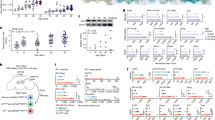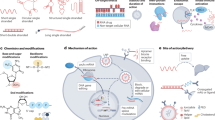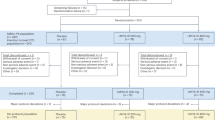Abstract
Parkinson's disease is a prevalent progressive degenerative disorder of the elderly. There is a current need for novel therapeutic strategies because the standard levodopa pharmacotherapy is only temporarily efficacious. Recently, there have been some high-profile successful preclinical results obtained in animal models of neurological disorders using small interfering RNAs delivered by viral vectors. RNA interference can theoretically be applied to Parkinson's disease since over-expression of various proteins is known to kill the dopamine neurons of the substantia nigra in animal models and in familial forms of Parkinson's disease. Potential RNA interfering strategies and caveats are discussed in this review.
This is a preview of subscription content, access via your institution
Access options
Subscribe to this journal
Receive 12 print issues and online access
$259.00 per year
only $21.58 per issue
Buy this article
- Purchase on Springer Link
- Instant access to full article PDF
Prices may be subject to local taxes which are calculated during checkout


Similar content being viewed by others
References
Ketting RF, Haverkamp TH, van Luenen HG, Plasterk RH . Mut-7 of C. elegans, required for transposon silencing and RNA interference, is a homolog of Werner syndrome helicase and RNaseD. Cell 1999; 99: 133–141.
Meister G, Tuschl T . Mechanisms of gene silencing by double-stranded RNA. Nature 2004; 431: 343–349.
Filipowicz W, Jaskiewicz L, Kolb FA, Pillai RS . Post-transcriptional gene silencing by siRNAs and miRNAs. Curr Opin Struct Biol 2005; 15: 331–341.
Tomari Y, Zamore PD . Perspective: machines for RNAi. Genes Dev 2005; 19: 517–529.
Jin P, Alisch RS, Warren ST . RNA and microRNAs in fragile X mental retardation. Nat Cell Biol 2004; 6: 1048–1053.
Reynolds A, Leake D, Boese Q, Scaringe S, Marshall WS, Khvorova A . Rational siRNA design for RNA interference. Nat Biotechnol 2004; 22: 326–330.
Schwarz DS, Hutvagner G, Du T, Xu Z, Aronin N, Zamore PD . Asymmetry in the assembly of the RNAi enzyme complex. Cell 2003; 115: 199–208.
Khvorova A, Reynolds A, Jayasena SD . Functional siRNAs and miRNAs exhibit strand bias. Cell 2003; 115: 209–216.
Dorsett Y, Tuschl T . siRNAs: applications in functional genomics and potential as therapeutics. Nat Rev Drug Discov 2004; 3: 318–329.
Akashi H, Matsumoto S, Taira K . Gene discovery by ribozyme and siRNA libraries. Nat Rev Mol Cell Biol 2005; 6: 413–422.
Luo B, Heard AD, Lodish HF . Small interfering RNA production by enzymatic engineering of DNA (SPEED). Proc Natl Acad Sci USA 2004; 101: 5494–5499.
Sen G, Wehrman TS, Myers JW, Blau HM . Restriction enzyme-generated siRNA (REGS) vectors and libraries. Nat Genet 2004; 36: 183–189.
Seyhan AA, Vlassov AV, Ilves H, Egry L, Kaspar RL, Kazakov SA et al. Complete, gene-specific siRNA libraries: production and expression in mammalian cells. RNA 2005; 11: 837–846.
Czauderna F, Fechtner M, Dames S, Aygun H, Klippel A, Pronk GJ et al. Structural variations and stabilising modifications of synthetic siRNAs in mammalian cells. Nucleic Acids Res 2003; 31: 2705–2716.
Hamada M, Ohtsuka T, Kawaida R, Koizumi M, Morita K, Furukawa H et al. Effects on RNA interference in gene expression (RNAi) in cultured mammalian cells of mismatches and the introduction of chemical modifications at the 3′-ends of siRNAs. Antisense Nucleic Acid Drug Dev 2002; 12: 301–309.
Prakash TP, Allerson CR, Dande P, Vickers TA, Sioufi N, Jarres R et al. Positional effect of chemical modifications on short interference RNA activity in mammalian cells. J Med Chem 2005; 48: 4247–4253.
Zhou H, Xia XG, Xu Z . An RNA polymerase II construct synthesizes short-hairpin RNA with a quantitative indicator and mediates highly efficient RNAi. Nucleic Acids Res 2005; 33: e62.
Boden D, Pusch O, Silbermann R, Lee F, Tucker L, Ramratnam B . Enhanced gene silencing of HIV-1 specific siRNA using microRNA designed hairpins. Nucleic Acids Res 2004; 32: 1154–1158.
Pardridge WM . Intravenous, non-viral RNAi gene therapy of brain cancer. Expert Opin Biol Ther 2004; 4: 1103–1113.
Akaneya Y, Jiang B, Tsumoto T . RNAi-induced gene silencing by local electroporation in targeting brain region. J Neurophysiol 2005; 93: 594–602.
Harper SQ, Staber PD, He X, Eliason SL, Martins IH, Mao Q et al. RNA interference improves motor and neuropathological abnormalities in a Huntington's disease mouse model. Proc Natl Acad Sci USA 2005; 102: 5820–5825.
Rodriguez-Lebron E, Denovan-Wright EM, Nash K, Lewin AS, Mandel RJ . Intrastriatal rAAV-mediated delivery of anti-huntingtin shRNAs induces partial reversal of disease progression in R6/1 Huntington's disease transgenic mice. Mol Ther 2005; 12: 618–633.
Xia H, Mao Q, Eliason SL, Harper SQ, Martins IH, Orr HT et al. RNAi suppresses polyglutamine-induced neurodegeneration in a model of spinocerebellar ataxia. Nat Med 2004; 10: 816–820.
Bjorklund A, Kirik D, Rosenblad C, Georgievska B, Lundberg C, Mandel RJ . Towards a neuroprotective gene therapy for Parkinson's disease: use of adenovirus, AAV and lentivirus vectors for gene transfer of GDNF to the nigrostriatal system in the rat Parkinson model. Brain Res 2000; 886: 82–98.
Mandel RJ, Burger C . Clinical trials in neurological disorders using AAV vectors: promises and challenges. Curr Opin Mol Ther 2004; 6: 482–490.
Blacklow NR, Hoggan MD, Sereno MS, Brandt CD, Kim HW, Parrott RH et al. A seroepidemiologic study of adenovirus-associated virus infection in infants and children. Am J Epidemiol 1971; 94: 359–366.
Erles K, Sebokova P, Schlehofer JR . Update on the prevalence of serum antibodies (IgG and IgM) to adeno-associated virus (AAV). J Med Virol 1999; 59: 406–411.
Peden CS, Burger C, Muzyczka N, Mandel RJ . Circulating anti-wild-type adeno-associated virus type 2 (AAV2) antibodies inhibit recombinant AAV2 (rAAV2)-mediated, but not rAAV5-mediated, gene transfer in the brain. J Virol 2004; 78: 6344–6359.
Burger C, Gorbatyuk OS, Velardo MJ, Peden CS, Williams P, Zolotukhin S et al. Recombinant AAV viral vectors pseudotyped with viral capsids from serotypes 1, 2, and 5 display differential efficiency and cell tropism after delivery to different regions of the central nervous system. Mol Ther 2004; 10: 302–317.
Mandel RJ, Spratt SK, Snyder RO, Leff SE . Midbrain injection of recombinant adeno-associated virus encoding rat glial cell line-derived neurotrophic factor protects nigral neurons in a progressive 6-hydroxydopamine-induced degeneration model of Parkinson's disease in rats. Proc Natl Acad Sci USA 1997; 94: 14083–14088.
Klein RL, Meyer EM, Peel AL, Zolotukhin S, Meyers C, Muzyczka N et al. Neuron-specific transduction in the rat septohippocampal or nigrostriatal pathway by recombinant adeno-associated virus vectors. Exp Neurol 1998; 150: 183–194.
Miller VM, Xia H, Marrs GL, Gouvion CM, Lee G, Davidson BL et al. Allele-specific silencing of dominant disease genes. Proc Natl Acad Sci USA 2003; 100: 7195–7200.
Venkatraman P, Wetzel R, Tanaka M, Nukina N, Goldberg AL . Eukaryotic proteasomes cannot digest polyglutamine sequences and release them during degradation of polyglutamine-containing proteins. Mol Cell 2004; 14: 95–104.
Bruijn LI, Houseweart MK, Kato S, Anderson KL, Anderson SD, Ohama E et al. Aggregation and motor neuron toxicity of an ALS-linked SOD1 mutant independent from wild-type SOD1. Science 1998; 281: 1851–1854.
Kabashi E, Agar JN, Taylor DM, Minotti S, Durham HD . Focal dysfunction of the proteasome: a pathogenic factor in a mouse model of amyotrophic lateral sclerosis. J Neurochem 2004; 89: 1325–1335.
Xie J, Awad KS, Guo Q . RNAi knockdown of Par-4 inhibits neurosynaptic degeneration in ALS-linked mice. J Neurochem 2005; 92: 59–71.
Daude N, Marella M, Chabry J . Specific inhibition of pathological prion protein accumulation by small interfering RNAs. J Cell Sci 2003; 116: 2775–2779.
Klockgether T . Parkinson's disease: clinical aspects. Cell Tissue Res 2004; 318: 115–120.
Nutt JG . Clinical pharmacology of levodopa-induced dyskinesia. Ann Neurol 2000; 47: S160–S164; discussion S164–S166.
Nutt JG . Motor fluctuations and dyskinesia in Parkinson's disease. Parkinsonism Relat Disord 2001; 8: 101–108.
Dunnett SB, Bjorklund A, Lindvall O . Cell therapy in Parkinson's disease – stop or go? Nat Rev Neurosci 2001; 2: 365–369.
Lozano AM, Mahant N . Deep brain stimulation surgery for Parkinson's disease: mechanisms and consequences. Parkinsonism Relat Disord 2004; 10 (Suppl 1): S49–S57.
Eriksen JL, Wszolek Z, Petrucelli L . Molecular pathogenesis of Parkinson disease. Arch Neurol 2005; 62: 353–357.
Tanner CM, Langston JW . Do environmental toxins cause Parkinson's disease? A critical review. Neurology 1990; 40 (Suppl): 17–30; discussion 30–31.
Tanner CM, Ottman R, Goldman SM, Ellenberg J, Chan P, Mayeux R et al. Parkinson disease in twins: an etiologic study. JAMA 1999; 281: 341–346.
Greenamyre JT, Hastings TG . Biomedicine. Parkinson's – divergent causes, convergent mechanisms. Science 2004; 304: 1120–1122.
Polymeropoulos MH, Lavedan C, Leroy E, Ide SE, Dehejia A, Dutra A et al. Mutation in the alpha-synuclein gene identified in families with Parkinson's disease. Science 1997; 276: 2045–2047.
Singleton AB, Farrer M, Johnson J, Singleton A, Hague S, Kachergus J et al. Alpha-Synuclein locus triplication causes Parkinson's disease. Science 2003; 302: 841.
Cookson MR . The Biochemistry of Parkinson's Disease. Annu Rev Biochem 2004; 74: 29–52.
Drolet RE, Behrouz B, Lookingland KJ, Goudreau JL . Mice lacking alpha-synuclein have an attenuated loss of striatal dopamine following prolonged chronic MPTP administration. Neurotoxicology 2004; 25: 761–769.
Kitada T, Asakawa S, Hattori N, Matsumine H, Yamamura Y, Minoshima S et al. Mutations in the parkin gene cause autosomal recessive juvenile parkinsonism. Nature 1998; 392: 605–608.
West A, Periquet M, Lincoln S, Lucking CB, Nicholl D, Bonifati V et al. Complex relationship between Parkin mutations and Parkinson disease. Am J Med Genet 2002; 114: 584–591.
Shimura H, Hattori N, Kubo S, Mizuno Y, Asakawa S, Minoshima S et al. Familial Parkinson disease gene product, parkin, is a ubiquitin-protein ligase. Nat Genet 2000; 25: 302–305.
Staropoli JF, McDermott C, Martinat C, Schulman B, Demireva E, Abeliovich A . Parkin is a component of an SCF-like ubiquitin ligase complex and protects postmitotic neurons from kainate excitotoxicity. Neuron 2003; 37: 735–749.
Yang Y, Nishimura I, Imai Y, Takahashi R, Lu B . Parkin suppresses dopaminergic neuron-selective neurotoxicity induced by Pael-R in Drosophila. Neuron 2003; 37: 911–924.
Perez FA, Palmiter RD . Parkin-deficient mice are not a robust model of parkinsonism. Proc Natl Acad Sci USA 2005; 102: 2174–2179.
Liu DX, Greene LA . Neuronal apoptosis at the G1/S cell cycle checkpoint. Cell Tissue Res 2001; 305: 217–228.
Bonifati V, Rizzu P, van Baren MJ, Schaap O, Breedveld GJ, Krieger E et al. Mutations in the DJ-1 gene associated with autosomal recessive early-onset parkinsonism. Science 2003; 299: 256–259.
Taira T, Saito Y, Niki T, Iguchi-Ariga SM, Takahashi K, Ariga H . DJ-1 has a role in antioxidative stress to prevent cell death. EMBO Rep 2004; 5: 213–218.
Valente EM, Abou-Sleiman PM, Caputo V, Muqit MM, Harvey K, Gispert S et al. Hereditary early-onset Parkinson's disease caused by mutations in PINK1. Science 2004; 304: 1158–1160.
Leroy E, Boyer R, Auburger G, Leube B, Ulm G, Mezey E et al. The ubiquitin pathway in Parkinson's disease. Nature 1998; 395: 451–452.
Alberi L, Sgado P, Simon HH . Engrailed genes are cell-autonomously required to prevent apoptosis in mesencephalic dopaminergic neurons. Development 2004; 131: 3229–3236.
Bantounas I, Glover CP, Kelly S, Iseki S, Phylactou LA, Uney JB . Assessing adenoviral hammerhead ribozyme and small hairpin RNA cassettes in neurons: inhibition of endogenous caspase-3 activity and protection from apoptotic cell death. J Neurosci Res 2005; 79: 661–669.
Lingor P, Koeberle P, Kugler S, Bahr M . Down-regulation of apoptosis mediators by RNAi inhibits axotomy-induced retinal ganglion cell death in vivo. Brain 2005; 128: 550–558.
Ji J, Wernli M, Mielgo A, Buechner SA, Erb P . Fas-ligand gene silencing in basal cell carcinoma tissue with small interfering RNA. Gene Therapy 2005; 12: 678–684.
Kirik D, Rosenblad C, Burger C, Lundberg C, Johansen TE, Muzyczka N et al. Parkinson-like neurodegeneration induced by targeted overexpression of alpha-synuclein in the nigrostriatal system. J Neurosci 2002; 22: 2780–2791.
Kirik D, Annett LE, Burger C, Muzyczka N, Mandel RJ, Bjorklund A . Nigrostriatal alpha-synucleinopathy induced by viral vector-mediated overexpression of human alpha-synuclein: a new primate model of Parkinson's disease. Proc Natl Acad Sci USA 2003; 100: 2884–2889.
Hommel JD, Sears RM, Georgescu D, Simmons DL, DiLeone RJ . Local gene knockdown in the brain using viral-mediated RNA interference. Nat Med 2003; 9: 1539–1544.
Acknowledgements
This work was supported by a Fast-track grant from the Michael J Fox Foundation to RJM and ASL.
Author information
Authors and Affiliations
Corresponding author
Rights and permissions
About this article
Cite this article
Manfredsson, F., Lewin, A. & Mandel, R. RNA knockdown as a potential therapeutic strategy in Parkinson's disease. Gene Ther 13, 517–524 (2006). https://doi.org/10.1038/sj.gt.3302669
Received:
Revised:
Accepted:
Published:
Issue Date:
DOI: https://doi.org/10.1038/sj.gt.3302669
Keywords
This article is cited by
-
Nano biomaterials based strategies for enhanced brain targeting in the treatment of neurodegenerative diseases: an up-to-date perspective
Journal of Nanobiotechnology (2023)
-
Development of elastin-like polypeptide for targeted specific gene delivery in vivo
Journal of Nanobiotechnology (2020)
-
Silencing of Hsp90 Chaperone Expression Protects Against 6-Hydroxydopamine Toxicity in PC12 Cells
Journal of Molecular Neuroscience (2014)
-
Novel siRNA delivery strategy: a new “strand” in CNS translational medicine?
Cellular and Molecular Life Sciences (2014)



